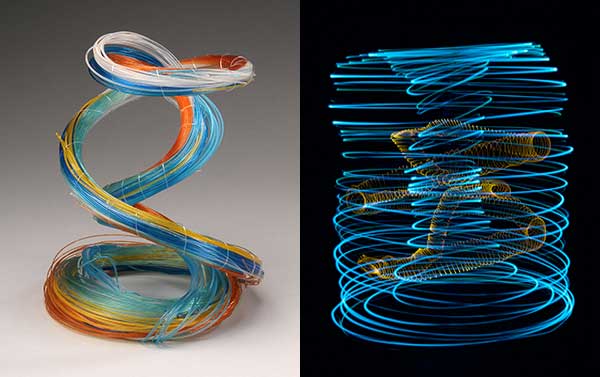The mysteries of the ocean, the enigmatic movements of its dizzying whorls, brought together Larry Pratt, a Senior Scientist at the Woods Hole Oceanographic Institution and teacher in the MIT/Woods Hole Joint Program, and Anastasia Azure, a textile artist and metalsmith. The two collaborated in an attempt to visualize and explore the fluid pathways of these spinning eddies as part of the exhibit “Ocean Stories: A Synergy of Art and Science,” sponsored by the Council for the Arts at MIT. The experience was so positive that they are working together again.
Pratt uses chaos theory to investigate the fluid pathways of eddies, often modeling turbulence and chaos and portraying these processes through photography and dance (during MIT’s Independent Activities Period, he taught a class on demonstrating the physical principles of fluid motion through modern dance). Azure, a RISD-trained textile sculptor, is inspired by “the elegance of geometry” and was motivated to participate in the project in order to bring a new level of meaning and narrative to her formal investigations of shape and material.
One result was a series of time-lapse, light-streak photographs by Azure and Pratt (who doubles as a fine art photographer). The streaks portray fluid pathways that wind their way about a three-dimensional eddy, following the surfaces of hidden objects shaped like doughnuts and twisted hula hoops. Pratt’s research also inspired a colorful and dynamic sculpture made by Azure from the skeins of dyed fishing line, woven on a traditional floor loom. Representing a cross-section of the eddy, the sculpture is a fascinating study of the complex forms that can occur in nature. As Azure writes in her artist statement, “The form is like a mandala and speaks to the essential structure of the universe as an ordered, yet chaotic, harmonious system.”
A sculpture by Azure and photos by Pratt and Azure will next be on display at the Boston Arts Academy exhibition, “The Creative Journey: Art Inspired by Science,” running from July 26-Sept. 20. They are also working on a new public art piece in New Bedford, MA that builds upon their previous work. Spiral Rope Eddy, as it’s called, “will connect fishing, sustainability, science, education and art in a waterfront community committed to stewardship,” according to the project’s website. Also inspired by the movement of eddies, the sculpture will be recycled from used commercial fishing line collected through shoreline clean-ups organized by the team. Azure and Pratt hope the piece will inspire greater ecological awareness in audiences. As Pratt remarks, scientists “need to speak to people in a different language” to communicate the urgency of their environmental research to the general public.

